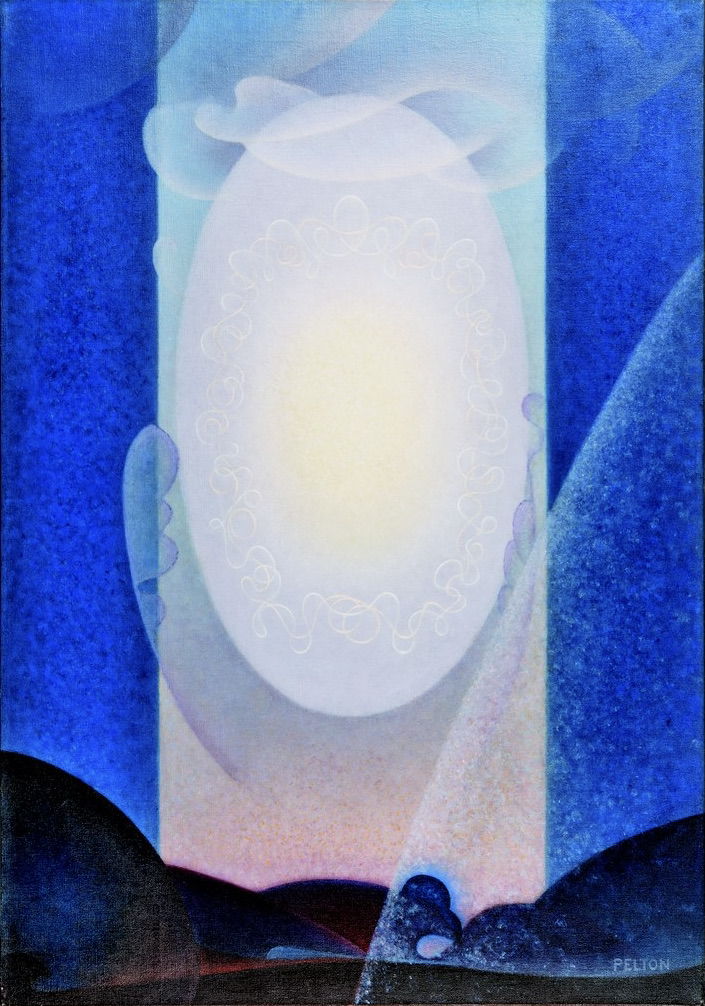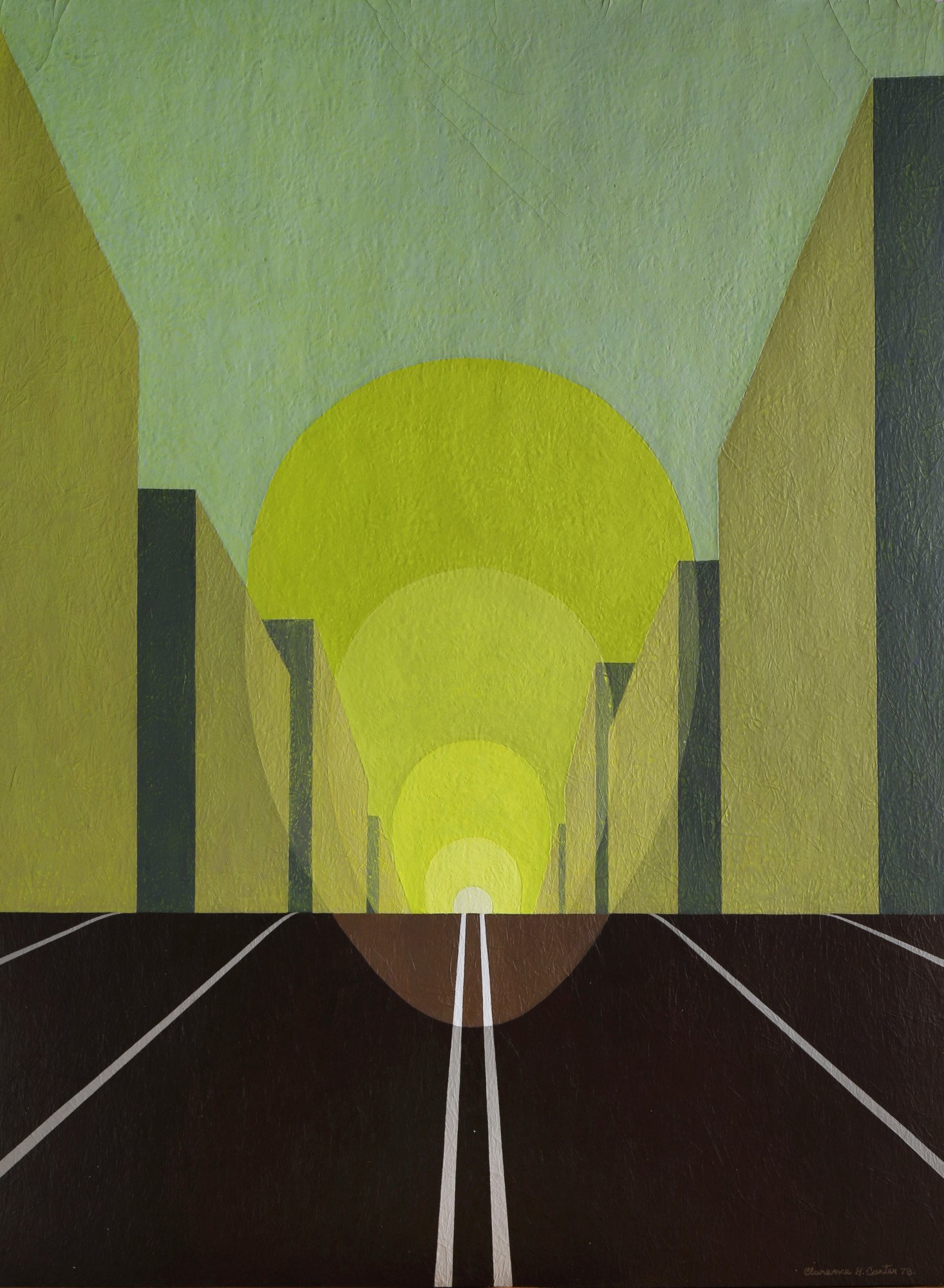

About the time the great depression began, Agnes Pelton moved from Long Island to the southern California desert. She was a solitary woman in her 50’s, an accomplished painter but short on money. She kept herself alive by selling desert landscapes to the tourists. It was her living but not her work. The desert had sunk its teeth in her far more deeply. The spirit of nature shone brightly here. The light showed her things. From time to time she sank into meditative trances and painted whatever made its way into her vision.
Pelton was called a transcendentalist. She did indeed engage in certain spiritual practices, such as theosophy, fire yoga, and astrology. They helped her get where she wanted to be. But transcendental is a sloppy word. It can mean pretty much whatever you purpose it to mean. Pelton’s purpose was to represent the soul without the encumbrance of matter, of flesh, but to do this via matter, in this case paint. It was a challenge, but she pulled it off. The effort pretty much consumed her.
Agnes Pelton lived a little more than a hundred miles from LA, but she never exhibited there in her lifetime. She exhibited very little anywhere. She died in 1961 and disappeared almost entirely from the consciousness of the art world. Two of her paintings showed up in a 1986 show at the Los Angeles County Museum of Art. This was her first appearance in the metro area. It failed to attract much attention.
Then came 2015, and Pelton’s work finally found a champion. Curator Gilbert Vicario had taken a job at the Phoenix Art Museum and was checking out the collection. In one of the rooms were two paintings by Pelton. He couldn’t take his eyes off them. Why didn’t he know about this artist? Well, she wasn’t going to stay unknown any longer. The would bring this woman by damn to light.
Vicario’s Pelton show opened in Phoenix then traveled to the Whitney Museum in New York. Sure enough, she became known quickly. Reviewers saw the show as a rare find from the hidden past, something entirely new from a time gone by. The New York Times gave it the stamp of approval, “There is nothing quite like Pelton’s paintings in 20th-century American art.”
Clarence Holbrook Carter was born a quarter century after Pelton, in a factory town on the Ohio river. Pelton’s father, when Agnes was ten, died from an overdose of morphine. When Carter was fourteen, his own father died of a stroke. They didn’t have much else in common. Pelton was a semi-recluse. Carter could be the life of the party. He enjoyed people very much. He just didn’t need them. Pelton lived hand to mouth. Carter made a good living. He was one of those rare artists who do. He could charm you. He could sell you a painting.
Carter wasn’t unknown. He had shows in New York galleries and work in major museums and positive reviews. Early in his career he was recognized as one of the better regionalists and later as a surrealist. What took the art world a while to notice was the spiritual aspect. It ran maybe too deep to be noticed easily.
Carter didn’t have a spiritual practice. He wasn’t a religious man. He wasn’t irreligious either. It just wasn’t where his inspiration came from so it didn’t much matter. The puzzle he left was to figure out where the inspiration did come from. How he evolved was to paint less from nature as it was and more from as he imagined the spiritual forces that brought nature to life. He stopped painting human figures entirely. First there was a series of animals starting out from behind walls. Some of these were amusing. Some were menacing. In all of them the force of life was potent. On a lion, the mane was somewhere midway between hair and flame. Over time he took leave of flesh entirely, animal or human.
Carter chose to live in the country. For a time he kept a pair of geese. The female did what female geese do. She laid eggs, fine big goose-eggs. The perfect form of them captivated him. They were silent, inscrutable. Inside life was taking shape, but until it hatched there was no visible display of it. You could call it an image of being between lives. You could call it all sorts of things.
The art was in the context. He started with collages, a screaming mouth, a weeping eye, pasted onto pure white ovoids. As his work evolved, it got rid of anything that could be seen as human and replaced it with pure patterns of concentric ovoids and circles. They functioned as mandalas. The colors were rich and resonant, drawing the viewer’s eye to the shimmering ovoid speck at the center, sometimes burning, sometimes cold as ice. They had the meditative effect of Rothko’ work. At a New York exhibition in the 70’s, some devotees of the Indian guru Meher Baba sat for hours in front of the paintings. Where the images took them, we can only guess.
The mandalas sold well. Carter could have spent the rest of his life painting them, peddling silk screen prints of them, moving them out the door. But that was not his way. His inspiration, like Pelton’s, was restless. Once he began repeating himself, he moved on.
He was stuck, however, with the ovoids. Whatever they were to him, they had commandeered his imagination. For as long as he put paint to canvas, they emerged. What changed were the settings.
Now came a series of paintings with translucent ovoids floating amidst buildings, architecture both modern and ancient. They loomed through archways and resurrected from crypts. He called these paintings “transections." They symbolized, for him, "the bridge between life and death, time and eternity.” You can perceive them however you want, as images of souls, of the inevitable miracle of life, of the creative voids that all effective art leaves for the viewer’s imagination to fill.
But he still wasn’t finished innovating. His final phase he called Eschatos, of the end times, of what comes last. These were wild landscapes populated only by a few lonely ovoids. That was all. There was no evidence that anything of flesh had ever been here.
When he was 90, Carter’s long career ended. His health failed, and he was no longer able to paint. With his last few canvasses, he’d returned to his transections but with a twist. The walls were crumbling, torn apart and consumed by flames. The fiery winds blew some of the ovoids off-kilter. These paintings fill in a gap in the narrative. They show us how the end times began.
There’s a handsome book of Carter’s art. The forward is by James Michener, who wrote “For some time I have suspected that forty years from now American collectors and museums will be searching for examples of Clarence Carter’s work. His canvasses will be appreciated both as masterful demonstrations of the painterly art and as high points of abstract expressionism.”
The book was published 32 years ago.
If you’re in LA, this is your chance to see what Michener saw and more. You can also see what Meher Baba’s devotee’s saw, as they sat cross-legged on the floor of that New York gallery.
Agnes Pelton lived only a few hours’ drive to the east, but Los Angeles was unaware of her. There’s no excuse for missing out on this successor of hers.
Being a geezer and making a trip of it.
Welcome to Tales from the Exit Ramp by me, John Carter. Half a century of professional writing of every variety: pulp fiction, industrial film, ad copy, tech documents, speeches, plays, poetry, tales, riffs.
